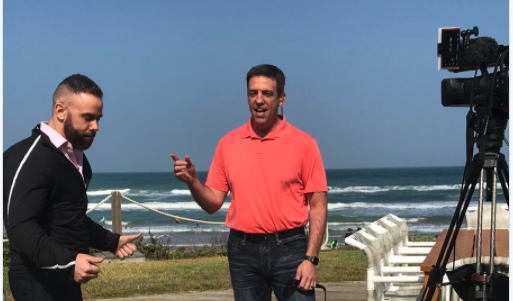 Josh Morgerman, left being interviewed by ABC 15 chief meteorologist Ed Piotrowski at the annual National Tropical Weather Conference in South Padre Island, Tex., last week.
Josh Morgerman, left being interviewed by ABC 15 chief meteorologist Ed Piotrowski at the annual National Tropical Weather Conference in South Padre Island, Tex., last week.Josh Morgerman is best known in West Hollywood for his creative work. His Symblaze was behind the design for the city’s The Pickup free weekend bar shuttle. He also created a hilarious video for Visit West Hollywood that called out the funny shallow and sexy aspects of the city’s culture, which turned out to be too much for the visitor and tourist bureau to handle.
But Morgerman is best known in certain international circles for his work as a storm chaser. That’s the role in which he unknowingly was responsible for Mexico’s failure to receive tens of millions of dollars in recovery funds from catastrophe or “CAT” bonds, following hurricanes such as Odile, which hit the Baja California peninsula in 2014.
CAT bonds are issued to investors by insurance companies that offer countries such as Mexico insurance policies meant to quickly provide funds for recovery from a major earthquake. By selling the bonds, the insurers get a quick supply of cash to fund other insurance policies and are able to pass along much of the risk. Buyers of the bonds, if lucky, see a good return on their investment if the revenue from those bonds isn’t tapped before they expire (typically three to five years).
The role WeHo’s storm chaser has played in the exposure of problems with catastrophe bonds was described in a story published Sunday in the Los Angeles Times that calls out major issues with the CAT bond program. Morgerman’s role in CAT bond funding also was noted in “The Storm Chaser and the Cat Bond,” a story published in 2017 by RMS, one of the leading catastrophic risk modeling companies.

One of the issues with the CAT bond program noted by the Los Angeles Times is the standards that insurers use to determine whether a hurricane is serious enough to qualify for a payout. An important criterion for that is the atmospheric pressure readings at the heart of a hurricane, a place where the inexhaustible Morgerman usually finds himself.
In its investigation CAT bonds, the Los Angeles Times cited Hurricane Odile, which in 2014 crossed the Baja California Peninsula in Mexico, causing damages estimated at $1.22 billion and cutting off up to 92% of the population. The Times story says that it was Morgerman’s “atmospheric pressure readings from a beachfront hotel (that) would up-end the entire system, denying the battered area any payout, while keeping the funds secure for investors through a shell company in the Cayman Islands.
“A year later, the same thrill-seeker’s data would help lower another projected payout, when Hurricane Patricia, the most powerful storm ever recorded in the Western Hemisphere, hit the western state of Jalisco.”
That is because, in addition to chronicling his storm chasing with photos and videos, and appearances on The Weather Channel and CNN, Morgerman used equipment to measure the central pressure of a hurricane. The insurance payout varies according to the pressure at the center of the hurricane, with the amount paid declining if the pressure exceeds a certain base. Morgerman’s measurement while holed up at a Holiday Inn Express near the very center of the hurricane saved bond investors $50 million – and denied Mexico’s disaster relief fund the same amount.
Morgerman has been chasing hurricanes since his youth, inspired in part by Hurricane Gloria’s destruction of his parents’ house on Long Island in 1985. His first foray into chasing hurricanes occurred when he was a student at Harvard University two decades ago doing an internship in Washington, D.C. He has evolved since then into using sophisticated tracking methods. During hurricane season (July or August till November is the peak time), Morgerman monitors computer models that predict where hurricanes will occur.
Morgerman told WEHOville that he found it strange that investors in CAT bonds had been following him.
“Yeah, the whole thing is weird,” he said. “I’ve been hunting cyclones and collecting data inside them for years. Then one day I start to notice these ‘suits’-money dudes-are following me on Twitter (@iCyclone): really taking an interest in my work, talking about it, etc. And I’m like, huh? I’m just a storm chaser. Why are they following me? What’s up with that?”
Morgerman also said “this whole insurance system seems stupid to me. It uses one single factor to rate the magnitude of the catastrophe — the hurricane’s central pressure at landfall. But that number is only a loose proxy for the hurricane’s destructive potential-just one piece of a bigger picture-and by itself doesn’t tell you a whole lot. More relevant factors would be the maximum sustained winds, the hurricane’s size, maybe rainfall totals-stuff like that. A hurricane is a complex machine-it can’t be reduced to a single number. So the system is fundamentally flawed.”
In any case, he added, “my passion is penetrating the centers of cyclones and collecting quality-controlled data. The end. I’m really not interested in this insurance and financial stuff. It’s not my scene, and it’s not relevant to what I do-and I dislike that I’ve been dragged into this whole discussion. If I was interested in this crap, I’d wear a suit and work on Wall Street-you know?”
